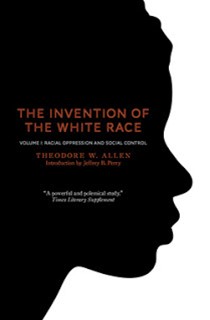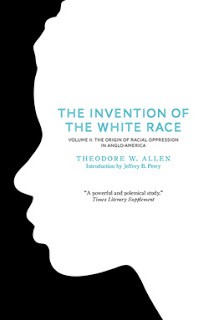The political origins of White Supremacy
By Hilary Barker, Penrith and the Borders CLP
The Invention of The White Race, by Theodore W Allen, is a large book in two volumes, but don’t let the thickness of this book put you off. The author spent twenty plus years studying in detail, the records of Virginia, from the first settlers onwards, and he concludes with his thoughts on how we got to the twenty-first century and how attitudes of racial superiority were created as a form of social control by the ruling elites of the time.
His underlying theory is that the “White race” was invented in response to an early rebellion/civil war known as Bacon’s Rebellion (1676-77). Prior to this rebellion there were no “white people”, in Virginia. He clarifies this by explaining that none of the official records make mention of the word ‘white’ as a description of any member of the population. It only becomes relevant once skin colour becomes a symbol of social status. White identity had to be taught because prior to that people were considered English, Irish, African or Indian.
Plantation labourers
Allen starts in 1607 at Jamestown, Virginia, and the problems of securing labour and establishing social control of said labour. Other European countries did not employ Europeans as plantation labourers, but the English did, and it is this difference which ultimately led to the origins of white racial oppression and eventually racial slavery.
He explains this difference as resulting from the end of the English Wars of the Roses (1450-85) and the rise of the cloth industry. This resulted in the launch of a cloth-making industry which transformed English economics through the accumulation of capital and the beginnings of a capitalist economic society. The price of wool rose faster than the price of grain and so began the replacement of arable land to pasture which required fewer labourers.
The later dissolution of the monasteries furthered this displacement, and the unemployment of labourers began to be a problem. There was a surplus of unemployed ex-soldiers and labourers. The proportion of people receiving poor relief was greater in this period (1631-40), than at any other time before or since.
‘Vagabonds’ turned into slaves
And so, one way of relieving the problem would be to make use of surplus workers by sending them to the colony of Virginia. They went as ‘bonded’ labourers, effectively as slaves. Any man found guilty of being a ‘vagabond’ by a law of 1547 was branded with a ‘V’ and made a bonded labourer for a period of two years for whoever had informed on him to the magistrates. He was to be fed only bread and water and scraps. He was to be chained and beaten and should he be caught after running away, branded with a letter ‘S’ and made a slave for life to the same owner he had tried to run away from. A second escape attempt was punishable by death.
Some were taken on as “apprentices” in the new Virginia colony, which was another form of bondage. Some even paid for their own passage on the promise of land after working as a ‘bondsman’ (ie for free, being only paid board) for a set period of time. Most did not survive because the death rate was incredibly high. It was little short of murder or suicide. Very few females made the journey and, anyway, bonded labourers were not allowed to marry or have children. Those men and women who did mix socially – it being a natural inclination – were severely punished, unless, that is, it was the master who did the ‘mixing’.
Basically, they were enslaved, but this was disguised by giving it another name, ‘bonded’ labour.

Skin colour as a means of social control
The native Americans refused on the whole to work in the plantations, as they saw no benefit or need. They had the whole hinterland of the continent in which to move and make a life. This led to some British and Irish bonded labourers running away to live with the Indians, and this, too, was severely punished, if escapees were caught.
Allen describes how later, after the Bacon Rebellion – which involved White and Black (ie English, Irish and African) bonded labourers in a common struggle – the very powerful ruling elite developed a system of social control that consciously and deliberately set the White bonded labourers against the Black labourers. In the latter case, their ‘bondage’ was extended by stages, first to ‘life bondage’ and ultimately to slavery.
He also describes how the ‘abolition’ of slavery, following the American Civil War, straight-forward terror, massacre and intimidation were used to make sure the Black population in the Southern states were battered into submission. So much so, that they were effectively no better off than they had been before ‘emancipation’ in terms of a political voice or economic prospects.
There is so much in this amazing book that it can’t be said in a short review. You will just have to read it for yourselves. I can’t do it justice here. It is very well-researched. I loved this aspect of it, as I learned so much; but although it is an ‘academic’ work it is still very readable. I admit to taking a long time to read it, but I did it in bite-sized chunks, which made it more manageable. I thoroughly recommend it.
Don’t let the size of the book put you off: only 259 pages out of 410 are the main body of the book, the rest are footnotes and appendices that you can read or not.
The Invention of the White Race is published by Verso and is available here.



